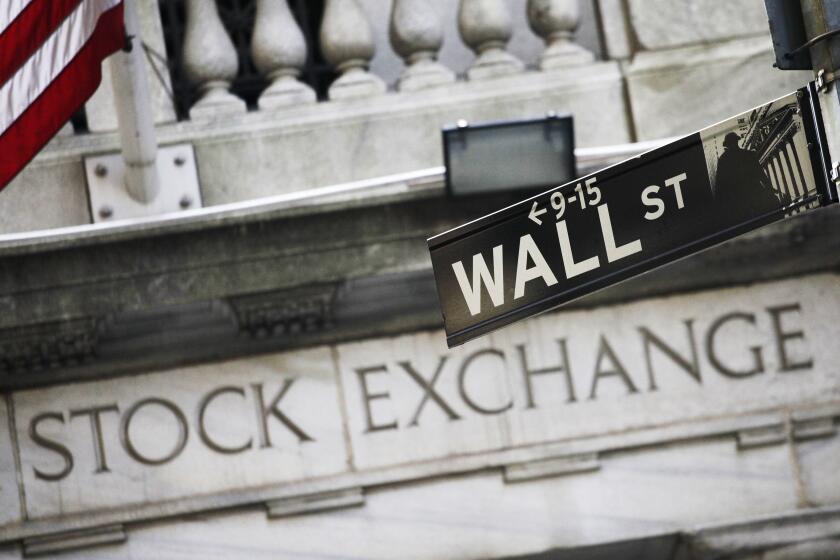Investing: A crossroads for bonds?
- Share via
Millions of small investors have poured their savings into bonds for the last few years, hoping to earn more than what cash accounts pay while avoiding the increasingly insane volatility of the stock market.
The strategy worked as advertised in the turbulent third quarter. Most categories of bond mutual funds produced positive returns in the three months ended Sept. 30, while most stock funds suffered double-digit percentage losses.
But the bond market, like the stock market, now may be at a critical crossroads: The next big moves in bonds may hinge on whether the struggling global economy falls into recession or stabilizes and sets up for renewed growth in 2012.
And with interest rates on high-quality bonds in low single digits, investors in search of decent returns can’t escape a basic financial reality: “You either accept higher risk or take a lower return,” said Neil Hokanson, head of wealth manager Hokanson Associates in Solana Beach.
There was more than a little irony in bonds’ performance last quarter. The rally was led by U.S. Treasury securities, which surged in value after America’s credit rating was downgraded Aug. 5 by Standard & Poor’s.
On the face of it, that made no sense. For the first time in history, the U.S. no longer was a AAA-rated borrower in S&P’s view. A lower credit rating is supposed to mean the debtor pays more to borrow. But just the opposite occurred: Investors rushed to buy Treasuries, driving market interest rates on the bonds to new generational lows in the quarter.
Investors may have been spooked by S&P’s move, but the effect was to make them more fearful of taking risks in other securities — not in Treasuries. Europe’s deepening government-debt crisis also drove investors to Uncle Sam’s debt.
As money poured into U.S. bonds, the annualized yield on the 10-year T-note sank from 3.16% at the end of June to a 60-year low of 1.72% by Sept. 22. As yields on new bonds fell, older bonds issued at higher fixed rates surged in value.
The result: The average fund that owns longer-term government bonds posted a total return of 6% in the third quarter, according to fund tracker Lipper Inc. Total return measures a fund’s income earnings plus the net gain or loss in principal value.
By contrast, the average U.S. stock fund plunged nearly 17% in the quarter.
The drop in Treasury yields also helped pull down market rates on other bonds, including high-quality corporate and municipal issues, in turn boosting share prices of funds that own them.
But not all bond sectors rallied. Fears that the global economy could be headed for another recession left Wall Street wary of higher-risk, higher-yielding bonds, particularly non-investment-grade, or junk, corporate issues. Market interest rates jumped in the junk market, driving down the value of older bonds.
The average junk bond fund had a negative total return of 6.6% in the quarter.
Funds that own bonds of emerging-market countries also tumbled, losing an average of 6.9% in the quarter. Global economic jitters drove government bond yields up in some emerging markets, including Russia and China. Foreign-bond funds, like foreign stock funds, also were hurt as the dollar soared against other major and minor currencies in the quarter. That depressed the value of securities denominated in foreign currencies when they were translated into dollars.
Still, even the worst of the bond fund losses in the third quarter were modest compared with the dive in domestic and foreign stock funds. Bonds did their job: They helped offset stock market volatility in a diversified portfolio.
But with interest rates on high-quality bonds now so low, that part of the market poses two challenges for investors.
One is that people seeking income can’t expect to earn much. A two-year Treasury note pays just 0.29% in annualized interest. Even longer-term securities pay little: the 30-year T-bond yields 3.02%. Bond fund annualized interest yields are mostly in the 2.5% to 4.5% range for portfolios of high-quality issues.
Second, if market interest rates should snap back, older bonds would fall in value.
“At these low levels of yields, it doesn’t take much to have a negative outcome” for bond fund total returns, warns Robert Rodriguez, veteran bond fund manager at First Pacific Advisors in Los Angeles.
What could cause yields to rebound? Anything that lifts some of the gloom over the global economy. Stronger U.S. economic data would help. So could progress in Europe to contain the debt crisis.
Last week, some surprisingly upbeat U.S. economic reports pushed the 10-year T-note to 2.08% by Friday, the highest since Sept. 15.
Some financial advisors recommend that clients looking for bond bargains edge into junk funds. Recession concerns drove the average yield on an index of 100 junk bonds tracked by KDP Investment Advisors to a 16-month high of 9.04% last Tuesday, up from 6.70% on Aug. 1. On Friday the yield was 8.72%.
“High yield is still our favorite asset class,” said Jeffrey Kleintop, chief market strategist at LPL Financial in Boston. The argument for junk is that the market is overreacting to the economic slowdown, and that bond defaults will remain low. Standard & Poor’s counts 32 defaults so far this year worldwide, down from a record 265 in 2009.
Martin Fridson, global credit strategist at BNP Paribas Asset Management in New York, also believes that the junk market at current yields offers “tremendous bargains” if the world avoids a severe recession. But noting how quickly the market can move if more big-money players exit, he advises investors to go slow in putting cash to work in junk.
In the 2008 financial system meltdown, the KDP index yield briefly reached nearly 18% amid panic selling.
Some investors may see parallels between the junk market now and what happened to tax-free muni bonds late last year, when yields spiked amid expectations of widespread muni defaults in 2011. Instead, the vast majority of state and local governments have continued to make good on their debts, despite strained finances.
Just 41 muni bonds worth a total of $1.2 billion have gone into default this year, down from 77 defaults totaling $2.7 billion in the same period of 2010, said Richard Lehmann, head of Income Securities Advisors Inc. in Miami Lakes, Fla. Total muni bonds outstanding are about $3 trillion.
As default fears have ebbed, muni market yields have tumbled for much of the year, lifting the value of older bonds. The average fund that owns long-term California tax-free muni bonds was up 9.3% in the first nine months.
Lately, however, muni yields have edged up. One source of pressure is President Obama’s proposal to take away some of the tax break on munis for the highest-income investors. But Republicans seem likely to oppose the change.
Some analysts assert that investors who want to own bonds as a haven should stick with U.S. government issues.
Lacy Hunt, chief economist at Hoisington Investment Management in Austin, Texas, believes that the debt burden the developed world has built up over the last three decades will remain a severe deflationary drag on growth for years to come. The result, he said, will be an ongoing slide in long-term Treasury yields as inflation worries fade and as investors choose safety amid continuing upheaval in growth-dependent markets, including stocks.
It doesn’t hurt, either, that the Federal Reserve last week launched a program to shift $400 billion of its shorter-term Treasury bond holdings into longer-term by July, hoping to pull long-term interest rates in general lower.
Hunt’s firm manages the Wasatch Hoisington U.S. Treasury fund, which is heavily invested in long-term government debt. The fund’s total return in the third quarter alone was a stunning 36.2% — nearly all of it from price appreciation as market interest rates dived.
As long-term rates swing, the portfolio can be extremely volatile, Hunt warns. Still, he thinks the shock in the U.S., as in Japan in the last two decades, will be how much further government bond yields will fall.
The 30-year Treasury bond yield already has crashed to 3.02% from 4.57% in January.
“But before this is over I think we’ll see 2% on the bond,” Hunt said.
More to Read
Inside the business of entertainment
The Wide Shot brings you news, analysis and insights on everything from streaming wars to production — and what it all means for the future.
You may occasionally receive promotional content from the Los Angeles Times.










